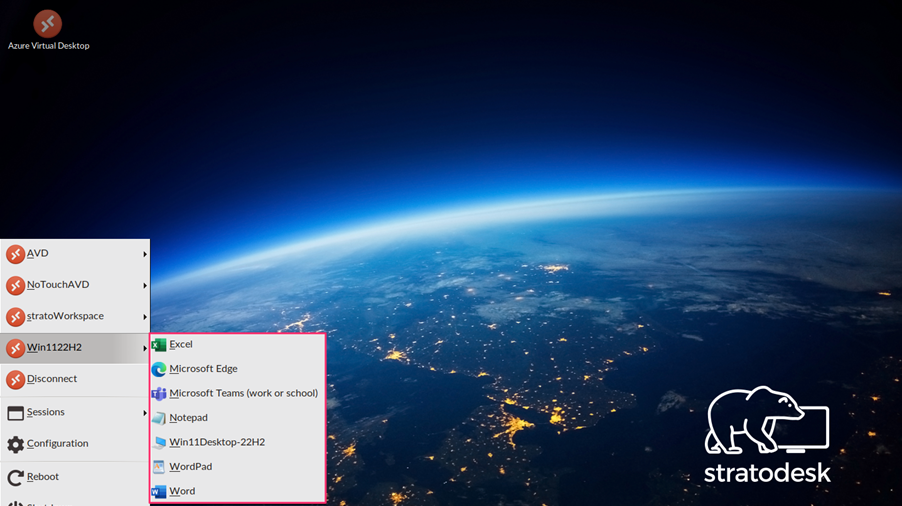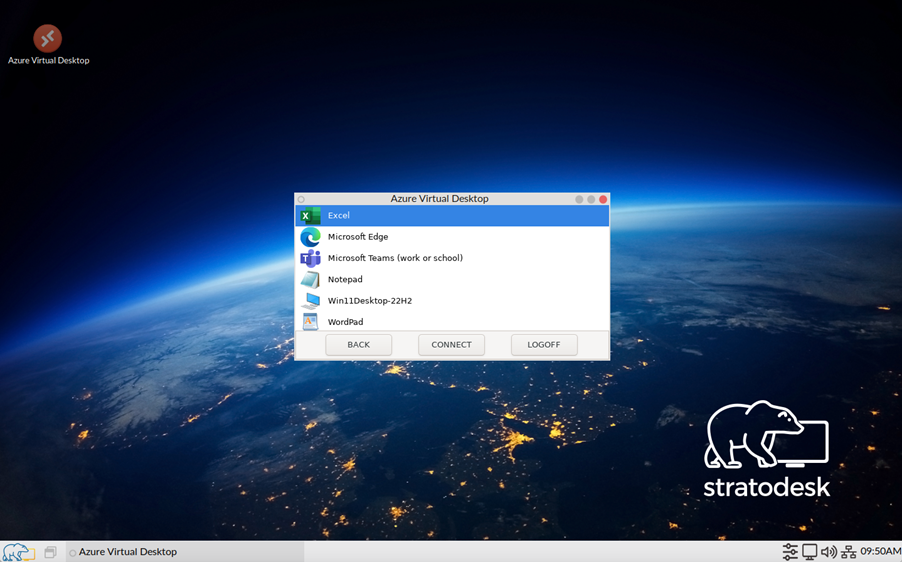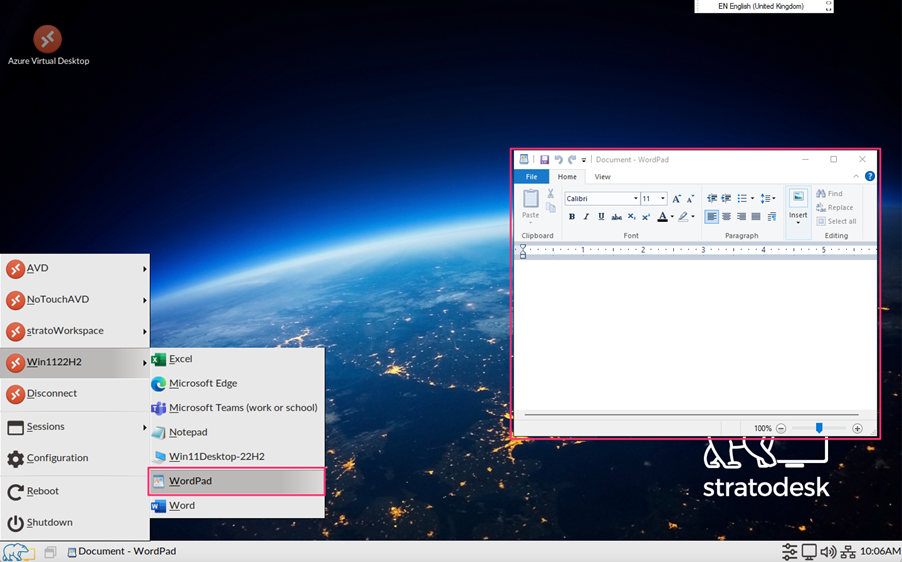Our dedicated Stratodesk development team has been diligently working to enhance the Azure Virtual Desktop & Windows 365 client with exciting new features and improvements. To fully experience these advancements, make sure you’re running the latest versions of NoTouch OS (3.4.788 or newer) and NoTouch Center (4.5.450 or higher). Take a look at the snapshot below for a comprehensive overview of the configurable parameters.

Let’s look at each of these new features in more detail.
RDP Filename
This is where you want to name the specific desktop or application you want to automatically start once authenticated. For example, if I have a desktop called Standard Desktop, then add Standard Desktop, and likewise for the name of any published applications. Please note that if this method is chosen then there is no application chooser, and applications are not shown in the start menu or desktop.
Resource feed URL
In most cases, you shouldn’t need to add anything here. US Government customers will use a separate URL than the default, but for convenience, we’ve added a separate field for this called Azure Cloud, which is set to auto by default, but can be configured with either public or U.S. Government.
Directory ID
Directory ID is now legacy and is only used to support older AVD images.
Audio Forwarding
Audio Forwarding refers to the speaker, i.e., audio “out”. Used for normal RDP session audio, not to be confused with Microsoft Teams which has its optimization parameter.
Microphone (audio in) Forwarding
Microphone Forwarding is turned off by default because of privacy, and is used for normal RDP session audio, not Microsoft Teams which has its own optimization parameter.
Printer Forwarding
When configured, this will forward all printers that are defined in the local system to the virtual desktop session.
Webcam Forwarding
Webcam Forwarding parameter like audio & microphone forwarding has nothing to do with Teams Optimization. It is for all other cases where you need a webcam in the VDI session. (e.g. Google Meet, GoToMeeting or so)
App Chooser
When enabled app chooser permanently displays the resource feed chooser on this screen, so is one of the easiest ways to have access to multiple applications rather than the desktop.
Desktop Icons
When enabled desktop icons permanently display all available applications & desktops as icons on the Stratodesk NoTouch Desktop. The example below shows duplicate application shortcuts as I have access to multiple resource feeds, but I’ve launched WordPad from my Win1122H2 which is highlighted.
Start Menu Integration
When enabled this displays the resource feeds in the start menu and is MY preferred way of configuring user access. Again, in the example below, this presents multiple resource feeds, and the desktop is less cluttered.
One Connection Only
When configured, this will automatically disconnect the session once an application or desktop session has been closed. If a user, then wants to start a different application or desktop they will need to reauthenticate before they can do so.
Smart Card Forwarding
This forwards attached smart cards to the virtual session. Please note that for this to work correctly, PCSC services need to be started which are configured in the Services Group Settings.
Teams Optimization
When enabled this optimizes Microsoft Teams in the session. Please note that this feature is currently experimental. You can verify that Microsoft Teams is optimized by going to ‘Settings/About/Version’ If configured correctly, will show that ‘AVD Media is Optimized’ as the example shows below.
Shortpath
Shortpath refers to a very specific RDP feature, please refer to appropriate Microsoft documentation for further configuration.
Use Server Timezone
This disables the automatic timezone forwarding and just uses whatever time Windows believes it is. Note – For timezone forwarding to work, the DWORD EnableTimeZoneRedirection needs to be set in HKLM\SOFTWARE\Policies\Microsoft\Windows NT\Terminal Services
Include System-Defined Drives in Mapping
By default, NoTouch OS reserves drive Z: which relates to where the local device mounts removable storage. If you want other, session-specific drives, please refer to our knowledge base for further information.
HTTP Proxy Address/Port
This allows for proxy configuration.
Auto logoff timeout (seconds)
If you don’t have ‘Only one connection’ defined and you have launched as the session (desktop or app, doesn’t matter) and you’ve closed that one, you will still be authenticated to the AVD environment. Now if you have not started another AVD session before the timeout timer is reached, you will be logged off. This is to prevent people who think they are logged off when they close an app/desktop, to walk away, and then someone comes after them and starts a session with the credentials of the previous user.
Mouse Scroll Speed
As the description suggests, this controls the mouse scroll speed and can be set between a value of 0 and 100, with 20 being the default. The higher the value, the faster will the mouse wheel scroll.
Command Line Parameters
The Stratodesk AVD/W365 client program, ntavdc, has additional options that allow you to customize the client further. The following parameters might be useful:
- ––disable-stratodeskvc: This disables the Stratodesk Virtual Channel if the event causes an issue with the user’s session.
- ––always-download-feeds: When configured, it will not ask the user if they want to download additional discovered resource feeds but will do this automatically.
- ––never-download-feeds: When configured, it will never download discovered additional feeds.
- ––disable-integrated-remoteapp: When configured, it will keep RemoteApp support but will disable the integrated (RAIL) remote app support – that is then the experience you currently have on a Raspberry Pi, one window that contains the apps. I will talk more about Remote Apps Integrated Locally (RAIL) later in this blog.
- ––debug: This will enable debug mode for the AVD client.
Dual Credential Login
Dual Credential Login is now legacy and is only used to support older AVD images.
Azure Cloud
Azure Cloud allows you to choose either public which is the default setting, or U.S. Government.
Now that we’ve looked at all the parameters, let’s look at the sign-in process for the end user. For this purpose, we have kept the configuration to a minimum.

Launch the AVD client and enter a username.
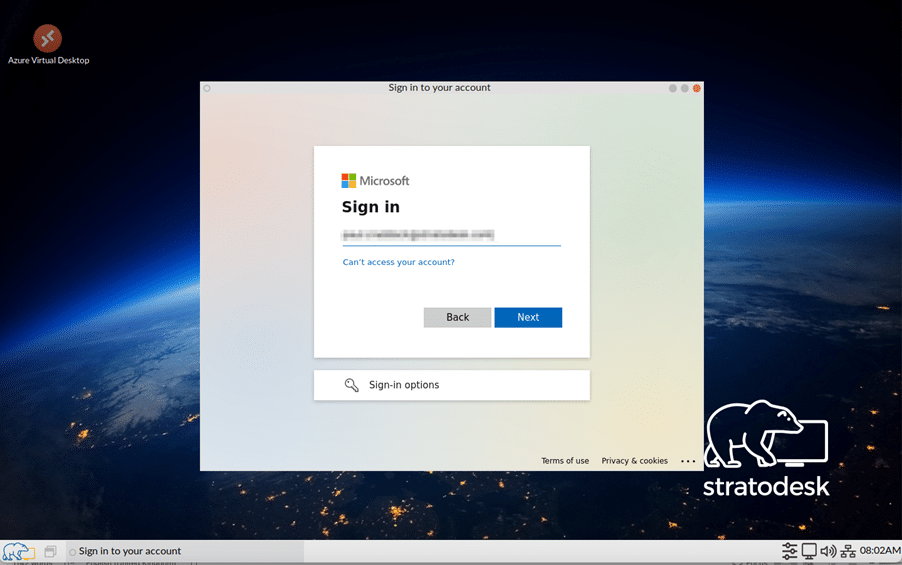
Enter the Password and any other MFA prompts.

Once authenticated, the following message prompt will appear on the screen.

If you click no, then it will load the default resource feed. If you click yes, then it will prompt you to log in with your username & password for the additional resource feed that you want to download. If you know that your users will not need to download an additional resource feed, then you can always configure the ‘Command Line Parameter’ with ‘––never-download-feeds’ which will then bypass this message.
My resources have now been loaded into the Start Menu as this is how I configured the settings in NoTouch Center.

From here I have the option of starting a desktop or any published application. The screenshot below shows the ‘Remote Apps Integrated Locally’ (RAIL) feature. Here I’ve launched WordPad, Notepad & Edge, but whilst doing so, I always have access to the local Stratodesk desktop so I can launch multiple applications.

It’s also possible to take advantage of the snap tool for the precise positioning of applications on the desktop. To make this work, simply drag the application to the top of the screen until the screen snap appears and position the application into the appropriate portion of the screen.
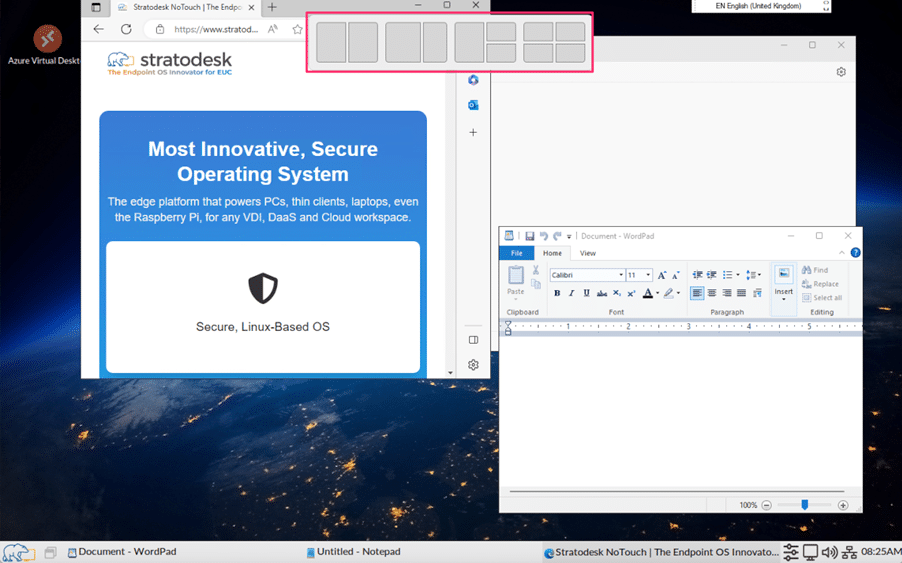
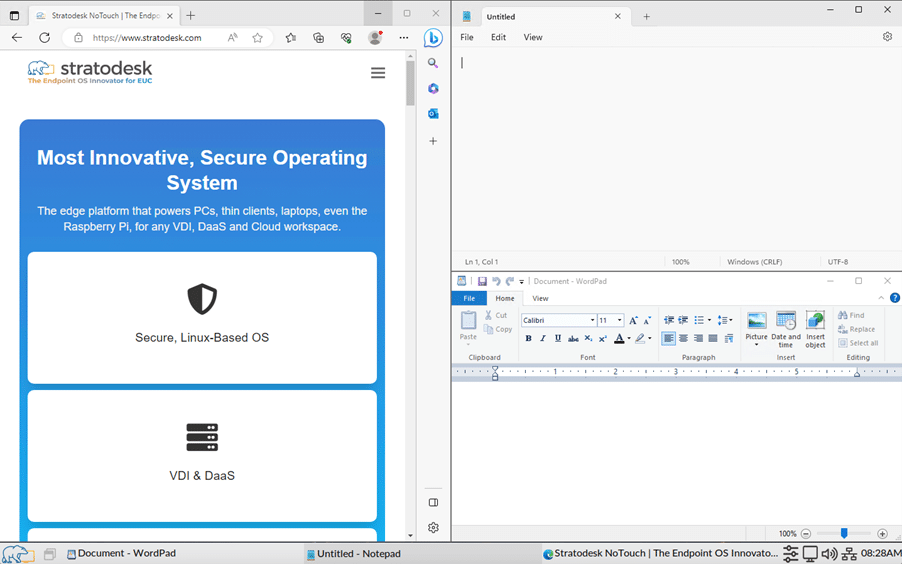
If users are accessing their applications this way rather than on a full desktop, then they will still be saving their work on the remote session either on the desktop itself or on say mapped network drives for example.
To end the session simply, click disconnect or it will automatically log off if a session timeout has been configured.

That concludes the comprehensive Azure Virtual Desktop & Windows 365 configuration walkthrough. I hope you found it valuable, and make sure to keep an eye out for our upcoming post where I will introduce StratodeskVC.exe. This utility will greatly enhance the value of our offering for Azure Virtual Desktop and Windows 365, providing enhanced security, event triggers, login scripts, and more.
Click here to watch a short video with updates and new features.

